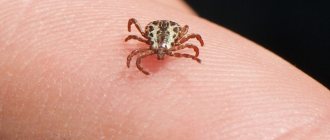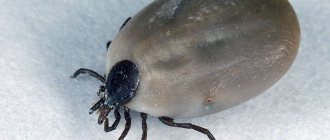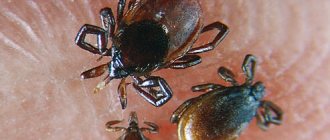Fighting mites on violets. What pests can live on violets. What they look like and what are the signs of infection. What harm is done to plants? Use of effective chemicals. Application of traditional methods. How to prevent infection.
We all know about pests that attack plants and cause great harm to flowers. When we notice that a violet begins to weaken without any reason, its leaves change color and shape, most likely a mite has settled on it. It is necessary to fight it as soon as the first symptoms of infection are noticed, since without taking any action, the pest can destroy the flower.
Next, we will find out what needs to be done if a mite appears on a violet, what chemicals and folk remedies can be used, and what preventive actions will prevent infection.
Description and appearance
Most often, the cyclamen mite appears on violets, which also affects other indoor plants. Azaleas, Kalanchoes, and cyclamen are at greatest risk of infection. But these pests harm not only indoor flowers, they also affect garden and vegetable crops. They have very small body sizes and it is simply impossible to see them on a flower without magnifying devices. They belong to the arachnids.
They have a translucent, oblong body, light yellow in color, and 8 legs. They live in buds and on young shoots. Their diet consists of plant sap. These pests multiply very quickly and within a few days after infection the colonies increase significantly.
One female lays 12 to 16 eggs daily, which require only 3-7 days to develop. A week after laying eggs, young individuals appear, which need nutrition and are ready for further reproduction. You can see what they look like in the photo.
Favorable conditions that contribute to their rapid reproduction are warmth and minimal humidity. Therefore, the peak of their activity for indoor plants occurs in winter, when apartments have heating. And for garden crops, such a favorable environment occurs in the summer, when hot and dry days arrive.
Signs of defeat
Since it is impossible to see the pest on a violet, infection can be determined from the external signs that appear on the flower. Something similar to a dusty coating appears on young shoots, buds, as well as young green leaves. The mite infestation is most noticeable on the leaves, as they change color, become dull, a yellow tint appears, then they turn brownish-gray and the leaves become deformed.
The petioles and leaves become very dry and brittle. Also, thin hairs similar to cobwebs appear on young leaves. The buds do not open and begin to fall off.
If such signs are detected, it is necessary to relocate the infected flower so that the pests do not attack neighboring flowers. You will need to immediately resort to treatment methods.
Fighting methods
There are many ways to combat this microscopic pest. You can use specialized chemicals or seek help from traditional methods.
Traditional methods
The most effective methods include bathing the violet at a certain water temperature. The procedure is as follows; at the first stage, you will need to remove severely affected leaves. Next, take a container and pour water at a temperature of 45°C into it. You will need a thermometer, since this method is effective precisely at this temperature; if it is higher, then you can harm the plant, and if it is insufficient, then the procedure will not bring any effect.
Next, you need to immerse the flower completely in water for 15 minutes. It is also necessary to maintain the correct temperature during the procedure. After the water procedure, it should be placed in a shaded place, and after a few days it can be returned to its original place.
Chemicals
As with traditional methods, a mandatory step is to remove the affected parts. Most often, acaricidal agents are used for treatment, which must be used to wipe the violet leaves. These include Akarin, Fitoverm, Aktofit, and others. Wiping is carried out every 3 days, then the time intervals are increased to 5. When the bush is very infected, they do not use wiping, but bathing, when the flower is completely immersed in the solution.
If we talk about insecticides, they are ineffective against pests. This is because ticks develop immunity to the active ingredients; in addition, the products are not capable of destroying egg laying. When carrying out treatments with acaricides, it is necessary to carry out several procedures in which the products are changed.
Antiklesch, Omite, Kleschevit, Neoron show fairly good effectiveness. But remember, treatment with these products should not be carried out in an apartment. After the procedure, the violet is covered with plastic wrap for up to 24 hours. The drugs are toxic and when using them, protective equipment must be used.
Description and differences
https://ogorodnash.ru/wp-content/uploads/2019/10/kleshh_na_fialkah2.LVoEr_
Three types of mites parasitize houseplants:
- Soft-bodied. Small, transparent insects whose body resembles an ellipse in shape. The length of the body reaches 0.2-0.3 mm. Parasites settle at the growing point of the plant and, in the case of violets and cyclamens, provoke thickening of the center of the rosette.
- Armored. Green or red in color, oval in shape, reaching 0.3-0.5 mm. They weave a thin web in which they live. They reproduce very quickly. From the laying of eggs to the appearance of adults and a full-fledged brood, about 10 days pass. Life expectancy reaches one month.
- Flat and spidery. Red or green, oval in shape. In the process of its life, it forms a web in which it lives and reproduces.
Strawberry, transparent and cyclamen mites on violets show traces of their vital activity at advanced stages of the lesion. It is very difficult to identify parasites immediately after infection. Due to its small size, it is impossible to detect a tick without special equipment.
Attention! Follow basic agrotechnical recommendations when growing Saintpaulia. They will help make your care as effective as possible. Regularly inspect the collection for pests - it is much easier to destroy them before they spread massively.
Often damage by this pest is a direct consequence of unorganized crop care. The florist does not comply with basic norms of agricultural technology and this leads to serious problems. Spider mites are easily bred in conditions of low humidity and elevated temperature. A favorable basis is the non-targeted use of nitrogen fertilizers. The trace element (nitrogen) is very dangerous for violets, so it is applied in doses and exclusively in the spring. The rest of the time, compositions enriched with potassium and magnesium are used, they provoke flowering and strengthen the immune system.
https://domashniecvety.ru/wp-content/uploads/c/6/1/c614cbca70eb4efd780473f67e576a65
Security measures
When using chemicals, it is imperative to wear rubber gloves, a respirator and clothing that covers the body. During processing, containers that are used in the kitchen and when preparing food are not used.
Do not use soap in solutions, as it will significantly reduce the effect of the active ingredients. Solutions for treatment should be prepared immediately before use, and the remains should be disposed of. The procedure must be carried out outdoors; when carried out in residential premises, it can harm the health of people and animals.
After the treatment is carried out, the bushes are placed in quarantine, where they will be isolated from other plants. After 3-4 weeks, it is necessary to inspect the violet, leaves and young shoots; when there are no signs of infection, the violet can be returned to other colors.
Preventing ticks
Simple preventive recommendations help to significantly reduce the likelihood of plant damage:
- treat new plants with acaricides and provide them with quarantine; it is permissible to place a new violet in the main collection no earlier than 3 weeks after the inspection;
- follow the recommended agrotechnical standards;
- promptly remove faded flower stalks and remove damaged leaves;
- in hot weather, rinse plants in the shower;
- carry out preventive treatment with insecticides in late spring;
- do not place flowers too closely together.
Attention! It makes no sense to re-root an adult violet before the mite is eliminated, just as it makes no sense to root its cuttings. This can be done after eliminating the pest, otherwise the manipulation will be pointless.
Useful video - learn how not to miss spider mite activity.
Controlling mites on indoor plants is quite difficult. Insecticidal preparations of systemic action help to destroy it quite quickly - when using them, a single application is enough. Finding and buying such products is problematic due to the high price, so flower growers use more affordable intestinal insecticides. They also show good results, but only when used correctly. It is impossible to use drugs with one active component to fight. The current remedy must be constantly changed to avoid addiction.
Other types of ticks
- Unfortunately, not only the cyclamen mite is dangerous for violets; plants can also infect other types of mites. One of them is a cobweb, which is no less dangerous and can lead to the death of a violet. These are small parasites that reach no more than 1 mm. In the warm season, they have a green body color, and in the fall and spring they change it to red.
- It is dangerous not only for violets; the pest affects berry and fruit crops. They also feed on plant sap. The product of their vital activity is a cobweb that envelops the flower, and it is by this that the infection can be determined. Acaricides and folk remedies are quite effective in combating it.
- Another dangerous species is the flat beetle; this mite affects violets, cacti, ficus, citrus fruits and other types of indoor plants. It has an ovoid body shape and can be yellow-orange or yellow-brown in color. When infected, the leaves begin to dry out, the plant weakens greatly and dies. Favorable conditions for reproduction are temperatures of 18-24°C, so they lay eggs all year round, which is why they pose a great danger. Acaricidal agents are used to combat them.
- Violets and root mites, as they are also called bulb mites, are not ignored. They infect plants underground; most often, orchids, gladioli, tulips, etc. are attacked by these pests. High humidity serves as favorable conditions for their reproduction. Bulbs should be stored only in dry rooms where the humidity level does not exceed 60%, which is an effective prevention.
Mite on violets. Kinds
Violet affected by a mite: photo
While mites are difficult to see, the harm they can cause to plants will be immediately noticeable. Most often, old foliage of violets is subject to infection. The underside of the leaves is covered with clearly visible depressed spots with a brown color; the foliage seems to be pierced with blunt needles.
- If you notice the presence of red dots on the leaves of a plant, surrounded by cobwebs, this means that the plant has been attacked by red spider mites. At the same time, the foliage of the plants begins to curl and dry out. Therefore, spider mites on violets are a malicious pest that must be gotten rid of immediately
- Another enemy of violets is the cyclamen mite. The cyclamen mite is capable of infecting young foliage in the center of the bush. The leaves are deformed, it is possible to observe the appearance of yellow spots, which have a round shape, while the center of the rosette becomes denser. The biggest danger may be that when violets are infected with cyclamen mites, the growth center dries out, which means the plant stops growing. The stems begin to shorten, the bases of the leaves acquire a gray coating. The buds stop developing, the flowers begin to crumple. The foliage becomes brittle and more pubescent.
- The violet flat beetle mite or the false spider mite are also dangerous Today, about 40 species of flat mite are known.
- Orange flat mites or greenhouse mites can cause great harm on violets . The insect is very small in size, so the greenhouse mite on violets is difficult to notice without a special magnifying device. However, the presence of the greenhouse mite on the violet can still be seen: the upper part of the foliage begins to become shagreened, as if pricked. In dry weather conditions, the edges of the foliage begin to curl down. Most often, the lower foliage of the plant is affected and begins to wither.
Preventive actions
- Of course, the main preventive action is proper plant care. This includes fertilizing, watering, maintaining the correct temperature and lighting. Most often, infection occurs on bushes that are weakened and do not receive the necessary care, but healthy bushes are no less vulnerable to pests.
- To prevent difficult situations, experts recommend regularly bathing plants. This should be done at a time when there is a peak in activity, namely dry and hot weather. In addition, it is recommended to move the bushes to other places during this period so that they are not adjacent to other plants.
- Bathing is carried out as follows. The procedure can only be carried out under running water. When using a basin or bucket, pests enter the water and re-infestation occurs. While holding the bush, it is necessary to wash the lower parts of each leaf.
- You can only wipe the leaves under water with your finger; using sponges and rags will help spread the pest throughout the bush. Avoid getting water into the pot, on the flowers and in the center of the rosette. Water at a temperature of 40°C is used, but during the flowering period the temperature is reduced, the water should be slightly warm.
- Water procedures are not carried out in winter if there is no heating. When rotten leaves are visible on the plant, the procedure is not carried out. When the procedure is completed, it is necessary to remove moisture from the leaves using a regular napkin.
Ways to combat ticks.
Uzambara violet.
Family Gesneriaceae - Gesneriaceae.
Genus Saintpaulia hybrida - Hybrid Saintpaulia.
African violet saintpaulia hybrid.
Ways to combat ticks.
When there is a suspicion of the presence of a mite on a violet, the following measures must be taken:
Point No. 1 - Selectively pour out soil from 2 or 3 cups and, after washing, check the roots. If the roots are healthy, the growth of young roots is normal, then see point 2.
Point No. 2 - If the roots are in perfect order, then we treat them three times with acaricides. Suspecting cyclamen mite, or polyphagotarzonemus. They also give a similar picture.
Point No. 3 - If after a couple of weeks after treatment the new leaves do not become normal, we begin to think about an imbalance of nutrients in the soil. We re-root the heads into new soil.
It is necessary to treat all surrounding plants, not only the one on which the insects were noticed - after all, they move quickly, and if you notice them on one violet, be sure that those standing nearby are also affected. It is advisable to remove the flower stalks.
It is advisable to wash all windows and window sills with soap or detergents, Fitoverm solution, alcohol-containing solution, flea and tick shampoo for animals to prevent the spread of the pest. The window sill, shelves, windows and cracks should be treated with an alcohol-containing solution.
First you need to remove, if possible, all flower stalks and affected plant organs. First of all, it is necessary to carry out mechanical removal of pests - completely wash the plant. In the early stages of damage, sometimes it is enough to wipe the plant with soap and subsequently spray it regularly, creating a humid atmosphere.
In this case, the concentrated soap solution should be applied using a sponge or by lowering the small plant into a bowl of soapy water. Do not wash off the solution and leave the plant in the soap for about 2 weeks, covered with plastic wrap. And only after that rinse in the shower.
The most effective in more severe cases of damage is the use of acaricides and insectoacaricides. It is advisable to wash the plant the day before treatment and allow it to dry. The most harmless drugs in apartments are those of the avermectin group. The important thing is that treatment alone is usually not enough.
The cyclamen mite, like the flat beetle, has periods of complete lack of nutrition when food poisons have no effect on it. Therefore, it will not be possible to limit yourself to just treating plants with chemicals. Repeated treatments are required at certain intervals.
These are contact preparations, so you need to spray the plants very well from all sides, including the underside. It can hide in the wilds of pubescence, and without a surfactant in the acaricide it is impossible to get to it. The growing point, the base of the rosette, the surfaces of the leaf blades and leaf cuttings are poured and sprayed generously and thoroughly. Because Mites have a habit of settling in the most inaccessible places of the plant; it is best to treat it entirely, dipping it into a solution with an acaricide.
The preparations are contact, that is, if the wetting is not 100% (for 100% wetting, it is advisable to lower the rosette into the solution) or were not sprayed properly, then this must be done again. When using Fitoverm and Agravertin, the concentration is 0.2-0.4%, and always 0.05% surfactant. No more, because both Fitoverm and Agrevertin are very sensitive to an alkaline environment.
If you treat the collection with Actellik at a concentration of no more than 0.1%. This Actellik will completely burn a partially damaged growing point, but there will be a greater likelihood that there will be no mite left on all other parts of the affected plant. Well, then we either cut off the growth point or simply take cuttings. It is necessary to trim the growing point of at least two or three plants in the collection after treatment, because the young rosettes that grow at the cutting site will be the best test for the destruction of this pest. If they are also depressed, it means that the fight is not over, more radical measures must be taken - throw everything away or soak the cuttings in a solution of this drug for 1-2 hours and try to take cuttings after that, that is, at least save something.
If the infection is strong, that is, you discovered it at the moment of lightening and suppression of the growth point of most of the collection, then it is necessary to block it. The plants were watered, after 2 days they were sprayed, after that it is better not to water them, then they were sprayed again, after spraying, after 1-2 days they were watered again, and sprayed a third time. To shorten the time it takes for larvae to hatch from eggs and reduce the timing of development phases, it is necessary to maintain the temperature, including at night, above 20 degrees Celsius, ideally plus 25, otherwise the drugs will not work.
Medicines against ticks (acaricides) are not systemic, they are contact, do not poison the plant, but poison the tick only when the solution comes into direct contact with it, and only on the adult form. Therefore, they only spray against ticks (with fanaticism and passion!). Moreover, they spray three times:
★ during the first spraying, adult ticks die or receive damage incompatible with life, but nymphs and eggs remain untouched: some do not feed, others are generally armored;
★ After a few days, the nymphs grow up, become adult ticks, and new nymphs hatch from the eggs. There are no new eggs, there was no one left to lay them. Our second spraying exterminates the new generation of adults. Only those that hatch from the eggs survive;
★ The third treatment after a few days destroys the third and final generation.
It makes no sense to treat “for prevention” against ticks. If it is not there, but we have treated it, then we do not receive protection in advance, because the drugs are only contact. If there is already a tick, but it is not yet visible, then a single treatment will not give anything, three times are needed, and this is no longer prevention, but a full-fledged treatment.
Scheme for residential premises. Acaricides used: Sunmite, Nissoran, any drug from the avermectin group (Fitoverm, Actofit, Akarin, Vertimek, etc.)
1) Treatment with Sunmite until completely wet at a consumption rate of 1 g per 1 liter of water. Sunmite destroys all forms of ticks, including eggs, larvae and adults. The drug has a contact effect, so it is necessary to carefully treat the plants. High-quality treatment with Sunmite gives a high probability of complete destruction of this pest of Saintpaulia and Streptocarpus in one go.
2) But, even when treated with Sanmit, it is necessary to re-treat after 5 days with Nissoran at a consumption rate of 0.5 g per 1 liter of water, together with any avermectin preparation (Actofit, Fitoverm, Akarin at a consumption rate of 10 ml per 1 liter of water , or Vertimek with a consumption rate of 1 ml per 1 liter of water). Using Sunmite repeatedly is not recommended; the pest quickly gets used to it.
The second scheme is for residential premises. Preparations used: Sunmite, Oberon (Judo).
1) The first treatment is also with Sunmite, the consumption rate is 1 g and 1 liter of water.
2) The second treatment 5 days after the first with Oberon (Judo) at a consumption rate of 0.3 ml per 1 liter of water.
It would be good to cover the treated plant with a plastic bag on top and not place it on the windowsill for 1-2 days. At the same time, the tick is so tenacious that it very successfully adapts to a certain drug, so they must be changed during subsequent treatments. It is better to carry out treatment in the evening. Unfortunately, there are practically no systemic acaricides that are safe for humans. When using these drugs, you need to remember that they are very toxic and harmful to humans.
But regarding the removal of leaves affected by mites, flower growers advise not to remove them. A violet, weakened by a mite invasion, and even poisoned by chemicals, is in dire need of effective photosynthesis in order to quickly restore leaf mass and its immunity. Old, even ugly, tick-bitten leaves will help with this. By removing them, we further weaken an already weakened plant. And only when new, healthy leaves grow, only then will it be possible to remove the old ones.
Acaricides are drugs used to combat different types of ticks. Ticks are not insects, so insecticides do not affect them. It is necessary to use acaricides or insectoacaricides. Medicines against ticks (acaricides) are not systemic, they are contact, do not poison the plant, but poison the tick only when the solution comes into direct contact with it, and only on the adult form!
All acaricides sold to the public are enteric contact, so careful handling is very important. If these are soil or root mites, then it is advisable to completely immerse them in the working fluid. A total of 3 treatments: the second treatment after 4 days, the third after 7 days. In rare cases, a fourth treatment is required, also after 7 days. Any insecticides that do not have acaricidal properties are not effective. You need to buy an acaricide for ticks, since insecticides do not work on ticks.
Avermectins do not pose any particular danger and are practically non-toxic if basic precautions are taken - they are products of soil fungi that act on the digestive system of insects and arthropods (mites). Such drugs are destroyed within 24 hours, so treatment can only be carried out with a freshly prepared solution of these drugs. The temperature in the room during and after treatment should not be lower than 20°C, but preferably higher by several degrees, otherwise the drugs will not work.
At the moment, they work great against ticks: 1) Spiromesifen - Oberon, JUDO, Forbid 4F. 2) Spirodiclofen - Envidor insectoacaricide.
Pyridabene, Sunmite, Taurus - a heaped teaspoon for 10 liters of water. Processing is possible only once a year. (the pest quickly gets used to it). It also exhibits ovicidal properties, i.e. destroys pest eggs. Therefore, a single high-quality treatment is often sufficient. Doesn't stink, low toxicity.
Hexythiazox, Nissoran - does not kill adults, but sterilizes them. Therefore, its use in repeated treatments is desirable. A teaspoon per 10 liters of water. It also exhibits ovicidal properties, i.e. destroys pest eggs. Destroys larvae. Therefore, a single high-quality treatment is often sufficient. Adults die a natural death. Doesn't stink, low toxicity.
Propargit, Omite 57 - also has fumigation properties. 15 ml per 10 liters of water. May slightly burn young tender leaves. But this drug has excellent acaricidal properties against any ticks. I don't recommend using Omite wettable powders, they are all expired and will burn your plants.
Amitraz, Mitak - 15 ml. for 10 liters of water.
Pirimiphos-methyl, Actellik - has fumigation and limited systemic properties. 20-30 ml per 10 liters of water. Organophosphorus drug. It belongs to hazard class 3, but due to its fumigation properties (evaporates) it is quite harmful.
Zolon, benzophosphate, fozalon - organophosphorus preparation, highly toxic, hazard class 2. 30 ml. for 10 liters of water. I don't recommend using it. Actellik would be better then.
Avermectins; Fitoverm, Aktofit - 100 ml. for 10 liters of water, Vermitek 10 ml. for 10 l. water. Mainly intestinal and weak contact effects. If the pest does not feed, the effectiveness of these drugs is reduced.
Bifenthrin, Caesar, Talstar. Only one treatment (the pest quickly gets used to it). Instant contact-intestinal action. 10 ml. for 10 liters of water. Low toxic. Preferably Caesar.











